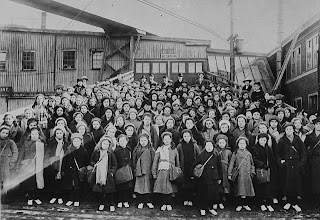Today, 4 million Canadians are descendants of British Home Children who immigrated to Canada between 1869 and 1939, mainly from England’s large cities. Brantford MP Phil McColeman, whose uncle was a home child, had a bill passed in Parliament declaring 2010 “The Year of the British Home Child”.
My great-grandma, Daisy Blay, was also a home child. Raised in London, England, her mother sold their furniture to pay the rent; her father died of liver cancer; and her baby sister of rickets. Eight-year-old Daisy was abandoned by her mother at the Barnardo Home in 1903.
The London of Daisy’s great-grandparents had quadrupled in size from 1821 to 1900. Late 19th Century residents were entertained by Jumbo the Elephant and terrorized by Jack the Ripper. While the world’s largest city had wealthy areas, the slums prevailed, portrayed in Charles Dickens’ Oliver Twist. The Industrial Revolution brought thousands of rural residents to the city; but low wages and limited jobs left 30% in poverty.
Victorian living conditions were appalling: lack of clean water led to infrequent bathing; charwomen dumped slop pails into the streets; smokestacks pumped fumes into the air; and tainted drinking water caused cholera outbreaks, killing thousands. Many adults preferred drinking beer, rather than the foul liquid from the River Thames, using it not just as a beverage but as a panacea.
Evangelical Dr. Thomas Barnardo treated cholera victims at a London East End slums. Preaching from a chair, Dr. Barnardo pleaded with East Enders to surrender their life to Christ. Finding “street arabs” on every corner, he opened Stepney House to shelter these waifs, two-thirds of whom still had one surviving parent. More Homes opened and their occupants were called “Home Children”.
With Stepney House full, Dr. Barnardo sent some wards to Canada. Adventures abounded on these trans-Atlantic passages. The Scotian, crossing two days before the Titanic, dodged icebergs complete with polar bears. The Sicilian dodged U-boats on a 1915 crossing. Ships carried up to 400 children and four parties sailed each year. Dr. Barnardo believed Canada offered the home children fresh air, a strong work ethic and good Christian values.
In 1903, Canada’s population was 5.3 million, only slightly more than London’s. The urban Britons experienced culture shock as they moved onto Canadian farms. Daisy’s home-child brother William was whipped if he didn’t milk the cows quickly enough, running away more than once. Many Barnardo children fled, often being found miles away, starving or even frozen to death. The average home child moved four times, often due to abuse, but sometimes due to a sponsor no longer needing them. Sometimes even peers showed disrespect: “Don’t play with her. She’s just a home child.” Not all home children were mistreated, however; occasionally, they were unofficially adopted by their sponsor.
Adult home children qualified to withdraw their wages earned (boys at 18, girls at 21), if the money wasn’t already used to bring a parent or sibling to Canada. Eleven thousand Barnardo boys served in World War I, including William. Barnardo girls took jobs as telephone operators, teachers and nurses. Despite a sad childhood, Daisy married and raised four healthy children, forging a strong Canadian identity as so many of the “little immigrants” did.
Photo courtesy http://web.ncf.ca

Great post! Your insights are truly valuable. If you need the Best Sop Help, feel free to reach out. I've had a fantastic experience with a service that offers top-notch assistance in crafting compelling statements of purpose. Highly recommended!
ReplyDelete